Hyperspectral Image Assessment of Archaeo-Paleoanthropological Stratigraphic Deposits from Atapuerca (Burgos, Spain)
Abstract
1. Introduction
2. Background and Geoarchaeological Characteristics
3. Materials and Methods, Experimental Procedures, and Signal Processing
3.1. Experimental Measures and Image Acquisition
Indirect and Direct Natural Lighting HSI Measurements
3.2. Data Processing: Endmember Extraction and Statistical Classification Methods
3.2.1. Preprocessing
3.2.2. Signal Processing, Data Extraction, and Treatment
3.2.3. Postprocessing, Data Modeling, and Image Classification
4. Results of Hyperspectral Analysis Under Indirect and Direct Natural Lighting Conditions
4.1. Experimental Measurement and Indirect Natural Lighting
4.2. Experimental Measurement and Direct Natural Lighting
5. Discussion
6. Conclusions
Author Contributions
Funding
Data Availability Statement
Acknowledgments
Conflicts of Interest
References
- Pavia, D.L.; Lampman, G.M.; Kriz, G.S.; Vyvyan, J.R. Introduction to Spectroscopy; Cengage Learning: Boston, MA, USA, 2014. [Google Scholar]
- Saha, D.; Manickavasagan, A. Machine learning techniques for analysis of hyperspectral images to determine quality of food products: A review. Curr. Res. Food Sci. 2021, 4, 28–44. [Google Scholar] [CrossRef]
- d’Oleire-Oltmanns, S.; Marzolff, I.; Peter, K.D.; Ries, J.B. Unmanned aerial vehicle (UAV) for monitoring soil erosion in Morocco. Remote Sens. 2012, 4, 3390–3416. [Google Scholar] [CrossRef]
- Miřijovský, J.; Langhammer, J. Multitemporal monitoring of the morphodynamics of a mid-mountain stream using UAS photogrammetry. Remote Sens. 2015, 7, 8586–8609. [Google Scholar] [CrossRef]
- Gomez, C.; Purdie, H. UAV-based Photogrammetry and Geocomputing for Hazards and Disaster Risk Monitoring–A Review. Geoenvironmental Disasters 2016, 3, 23. [Google Scholar] [CrossRef]
- Adão, T.; Hruška, J.; Pádua, L.; Bessa, J.; Peres, E.; Morais, R.; Sousa, J.J. Hyperspectral imaging: A review on UAV-based sensors, data processing and applications for agriculture and forestry. Remote Sens. 2017, 9, 1110. [Google Scholar] [CrossRef]
- Asner, G.P.; Wessman, C.A.; Bateson, C.A.; Privette, J.L. Impact of tissue, canopy, and landscape factors on the hyperspectral reflectance variability of arid ecosystems. Remote Sens. Environ. 2000, 74, 69–84. [Google Scholar] [CrossRef]
- Transon, J.; d’Andrimont, R.; Maugnard, A.; Defourny, P. Survey of hyperspectral earth observation applications from space in the sentinel-2 context. Remote Sens. 2018, 10, 157. [Google Scholar] [CrossRef]
- Urbanos, G.; Martín, A.; Vázquez, G.; Villanueva, M.; Villa, M.; Jimenez-Roldan, L.; Sanz, C. Supervised Machine Learning Methods and Hyperspectral Imaging Techniques Jointly Applied for Brain Cancer Classification. Sensors 2021, 21, 3827. [Google Scholar] [CrossRef]
- Fischer, C.; Kakoulli, I. Multispectral and hyperspectral imaging technologies in conservation: Current research and potential applications. Stud. Conserv. 2006, 51 (Suppl. S1), 3–16. [Google Scholar] [CrossRef]
- Picollo, M.; Cucci, C.; Casini, A.; Stefani, L. Hyper-spectral imaging technique in the cultural heritage field: New possible scenarios. Sensors 2020, 20, 2843. [Google Scholar] [CrossRef]
- Jacq, K.; Debret, M.; Fanget, B.; Coquin, D.; Sabatier, P.; Pignol, C.; Arnaud, F.; Perrette, Y. Theoretical Principles and Perspectives of Hyperspectral Imaging Applied to Sediment Core Analysis. Quaternary 2022, 5, 28. [Google Scholar] [CrossRef]
- Linderholm, J.; Geladi, P.; Gorretta, N.; Bendoula, R.; Gobrecht, A. Near infrared and hyperspectral studies of archaeological stratigraphy and statistical considerations. Geoarchaeology 2019, 34, 311–321. [Google Scholar] [CrossRef]
- Doneus, M.; Verhoeven, G.; Atzberger, C.; Wess, M.; Ruš, M. New ways to extract archaeological information from hyperspectral pixels. J. Archaeol. Sci. 2014, 52, 84–96. [Google Scholar] [CrossRef]
- Guanter, L.; Richter, R.; Moreno, J. Spectral calibration of hyperspectral imagery using atmospheric absorption features. Appl. Opt. 2006, 45, 2360–2370. [Google Scholar] [CrossRef]
- Peyghambari, S.; Zhang, Y. Hyperspectral remote sensing in lithological mapping, mineral exploration, and environmental geology: An updated review. J. Appl. Remote Sens. 2021, 15, 031501. [Google Scholar] [CrossRef]
- Ortega, A.I.; Benito-Calvo, A.; Pérez-González, A.; Martín Merino, M.A.; Pérez-Martínez, R.; Parés, J.M.; Aramburu, A.; Arsuaga, J.L.; Bermúdez de Castro, J.M.; Carbonell, E. Evolution of multilevel caves in the Sierra de Atapuerca (Burgos, Spain) and its relation to human occupation. Geomorphology 2013, 196, 122–137. [Google Scholar] [CrossRef]
- Ortega, A.I.; Benito-Calvo, A.; Martín, M.A.; Pérez-González, A.; Parés, J.M.; Bermúdez de Castro, J.M.; Arsuaga, J.L.; Carbonell, E. Las cuevas de la Sierra de Atapuerca y el uso del paisaje kárstico durante el Pleistoceno (Burgos, España). Boletín Geológico Y Min. 2018, 129, 083–106. [Google Scholar] [CrossRef]
- Benito-Calvo, A.; Pérez González, A. Geomorphology of the Sierra de Atapuerca and the Middle Arlanzón Valley (Burgos, Spain). J. Maps 2015, 11, 535–544. [Google Scholar] [CrossRef]
- Benito-Calvo, A.; Ortega, A.I.; Navazo, M.; Moreno, D.; Pérez-Gonzalez, A.; Parés, J.M.; Bermúdez De Castro, J.M.; Carbonell, E. Pleistocene geodynamic evolution of the Arlanzón valley: Implications for the formation of the endokarst system and the open air archaeological sites of the Sierra de Atapuerca (Burgos, España). Boletín Geológico Y Min. 2018, 129, 059–082. [Google Scholar] [CrossRef]
- Martínez-Fernández, A.; Benito-Calvo, A.; Campaña, I.; Ortega, A.I.; Karampaglidis, T.; de Castro, J.M.B.; Carbonell, E. 3D monitoring of Paleolithic archaeological excavations using terrestrial laser scanner systems (Sierra de Atapuerca, Railway Trench sites, Burgos, N Spain). Digit. Appl. Archaeol. Cult. Herit. 2020, 19, e00156. [Google Scholar] [CrossRef]
- Campaña, I.; Benito-Calvo, A.; Pérez-González, A.; Ortega, A.I.; Bermúdez De Castro, J.M.; Carbonell, E. Using 3D models to analyse stratigraphic and sedimentological contexts in archaeo-palaeo-anthropological Pleistocene sites (Gran Dolina site, Sierra de Atapuerca). In CAA 2015 Keep the Revolution Going, Proceedings of the 43rd Annual Conference on Computer Applications and Quantitative Methods in Archaeology; Campana, S., Scopigno, R., Carpentiero, G., Cirillo, M., Eds.; Archeopress: Oxford, UK, 2016; pp. 337–345. [Google Scholar]
- Campaña, I.; Benito-Calvo, A.; Pérez-González, A.; Ortega, A.I.; Bermúdez de Castro, J.M.; Carbonell, E. Pleistocene sedimentary facies of the Gran Dolina archaeo-paleoanthropological site (Sierra de Atapuerca, Burgos, Spain). Quat. Int. 2017, 433, 68–84. [Google Scholar] [CrossRef]
- Campaña, I. Estratigrafía y Sedimentología del Yacimiento de Gran Dolina (Sierra de Atapuerca, Burgos). Ph.D. Thesis, University of Burgos, Burgos, Spain, 2018. [Google Scholar] [CrossRef]
- Bermúdez de Castro, J.M.; Arsuaga, J.L.; Carbonell, E.; Rosas, A.; Martínez, I.; Mosquera, M. A Hominid from the lower Pleistocene of Atapuerta, Spain: Possible ancestor to Neandertals and modern humans. Science 1997, 276, 1392–1395. [Google Scholar] [CrossRef] [PubMed]
- Carbonell, E.; Bermúdez de Castro, J.M.; Parés, J.M.; Pérez-González, A.; Cuenca-Bescos, G.; Ollé, A.; Mosquera, M.; Huguet, R.; van der Made, J.; Rosas, A.; et al. The first hominin of Europe. Nature 2008, 452, 465–469. [Google Scholar] [CrossRef] [PubMed]
- Ollé, A.; Mosquera, M.; Rodríguez, X.P.; de Lombera-Hermida, A.; García-Antón, M.D.; García-Medano, P.; Peña, L.; Menéndez, L.; Navazo, M.; Terradillos, M.; et al. The Early and Middle Pleistocene technological record from Sierra de Atapuerca (Burgos, Spain). Quat. Int. 2013, 295, 138–167. [Google Scholar] [CrossRef]
- Rodríguez, J.; Burjachs, F.; Cuenca-Bescós, G.; García, N.; Van der Made, J.; Pérez González, A.; Blain, H.-A.; Expósito, I.; López-García, J.M.; García Antón, M.; et al. One million years of cultural evolution in a stable environment at Atapuerca (Burgos, Spain). Quat. Sci. Rev. 2011, 30, 1396–1412. [Google Scholar] [CrossRef]
- Benito-Calvo, A.; Ortega, A.I.; Pérez-González, A.; Campaña, I.; Bermúdez de Castro, J.M.; Carbonell, E. Palaeogeographical reconstruction of the Sierra de Atapuerca Pleistocene sites (Burgos, Spain). Quat. Int. 2017, 433, 379–392. [Google Scholar] [CrossRef]
- Moreno, D.; Falguères, C.; Pérez-González, A.; Duval, M.; Voinchet, P.; Benito-Calvo, A.; Ortega, A.I.; Bahain, J.J.; Sala, R.; Carbonell, E.; et al. ESR chronology of alluvial deposits in the Arlanzón valley (Atapuerca, Spain): Contemporaneity with Atapuerca Gran Dolina site. Quat. Geochronol. 2012, 10, 418–423. [Google Scholar] [CrossRef]
- Parés, J.M.; Arnold, L.; Duval, M.; Demuro, M.; Pérez-González, A.; Bermúdez de Castro, J.M.; Carbonell, E.; Arsuaga, J.L. Reassessing the age of Atapuerca-TD6 (Spain): New paleomagnetic results. J. Archaeol. Sci. 2013, 40, 4586–4595. [Google Scholar] [CrossRef]
- Moreno, D.; Falguères, C.; Pérez-González, A.; Voinchet, P.; Ghaleb, B.; Despriée, J.; Bahain, J.-J.; Sala, R.; Carbonell, E.; Bermúdez de Castro, J.M.; et al. New radiometric dates on the lowest stratigraphical section (TD1 to TD6) of Gran Dolina site (Atapuerca, Spain). Quat. Geochronol. 2015, 30, 535–540. [Google Scholar] [CrossRef]
- Headwall Photonics Inc. Hyperspectral Imaging Sensors: Hyperspec VNIR. Available online: https://www.headwallphotonics.com/products/vnir-400-1000nm (accessed on 10 May 2025).
- Kale, K.V.; Solankar, M.M.; Nalawade, D.B.; Dhumal, R.K.; Gite, H.R. A research review on hyperspectral data processing and analysis algorithms. Proceedings of the national academy of sciences. India Sect. A Phys. Sci. 2017, 87, 541–555. [Google Scholar] [CrossRef]
- Polder, G.; van der Heijden, G.W.; Keizer, L.P.; Young, I.T. Calibration and characterisation of imaging spectrographs. J. Near Infrared Spectrosc. 2003, 11, 193–210. [Google Scholar] [CrossRef]
- Chang, C.I.; Du, Q. Estimation of number of spectrally distinct signal sources in hyperspectral imagery. IEEE Trans. Geosci. Remote Sens. 2004, 42, 608–619. [Google Scholar] [CrossRef]
- Winter, M.E. N-FINDR: An algorithm for fast autonomous spectral end-member determination in hyperspectral data. In Proceedings of the SPIE 3753, Imaging Spectrometry V, Denver, CO, USA, 19–21 July 1999. [Google Scholar] [CrossRef]
- Debba, P.; Carranza, E.J.; van der Meer, F.D.; Stein, A. Abundance estimation of spectrally similar minerals by using derivative spectra in simulated annealing. IEEE Trans. Geosci. Remote Sens. 2006, 44, 3649–3658. [Google Scholar] [CrossRef]
- Kruse, F.A.; Lefkoff, A.B.; Boardman, J.W.; Heidebrecht, K.B.; Shapiro, A.T.; Barloon, P.J.; Goetz, A.F.H. The Spectral Image Processing System (SIPS) Interactive Visualization and Analysis of Imaging Spectrometer Data. Remote Sens. Environ. 1993, 44, 145–163. [Google Scholar] [CrossRef]
- Kay, S.M. Fundamentals of Statistical Signal Processing: Estimation Theory; Prentice-Hall, Inc.: Hoboken, NJ, USA, 1993. [Google Scholar]
- Somers, B.; Asner, G.P.; Tits, L.; Coppin, P. Endmember variability in spectral mixture analysis: A review. Remote Sens. Environ. 2011, 115, 1603–1616. [Google Scholar] [CrossRef]
- Zhao, Y.; Liu, B.; Wang, X.; Xu, X.; Zhang, H. Hyperspectral analysis and classification of loess-paleosol sequences based on spectral indices and support vector machine. Int. J. Appl. Earth Obs. Geoinf. 2019, 79, 111–123. [Google Scholar] [CrossRef]
- Bardelli, L.; Cattaneo, C.; Colombo, A.; Ricci, M.; Zerbi, C.M. Hyperspectral imaging applied to cultural heritage: Classification and mapping of pigment traces in prehistoric rock art. Spectrochim. Acta Part A Mol. Biomol. Spectrosc. 2020, 229, 117998. [Google Scholar] [CrossRef]
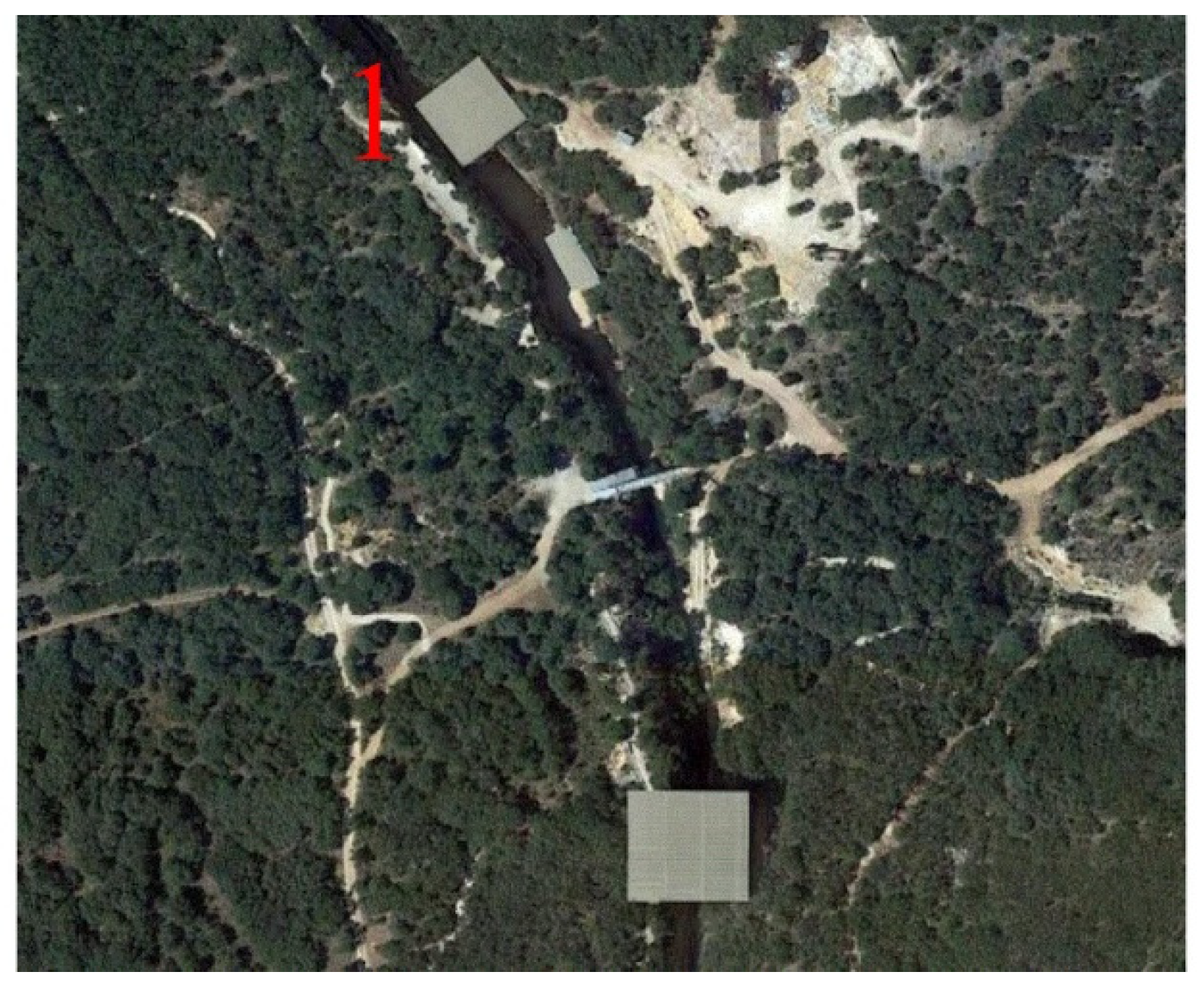
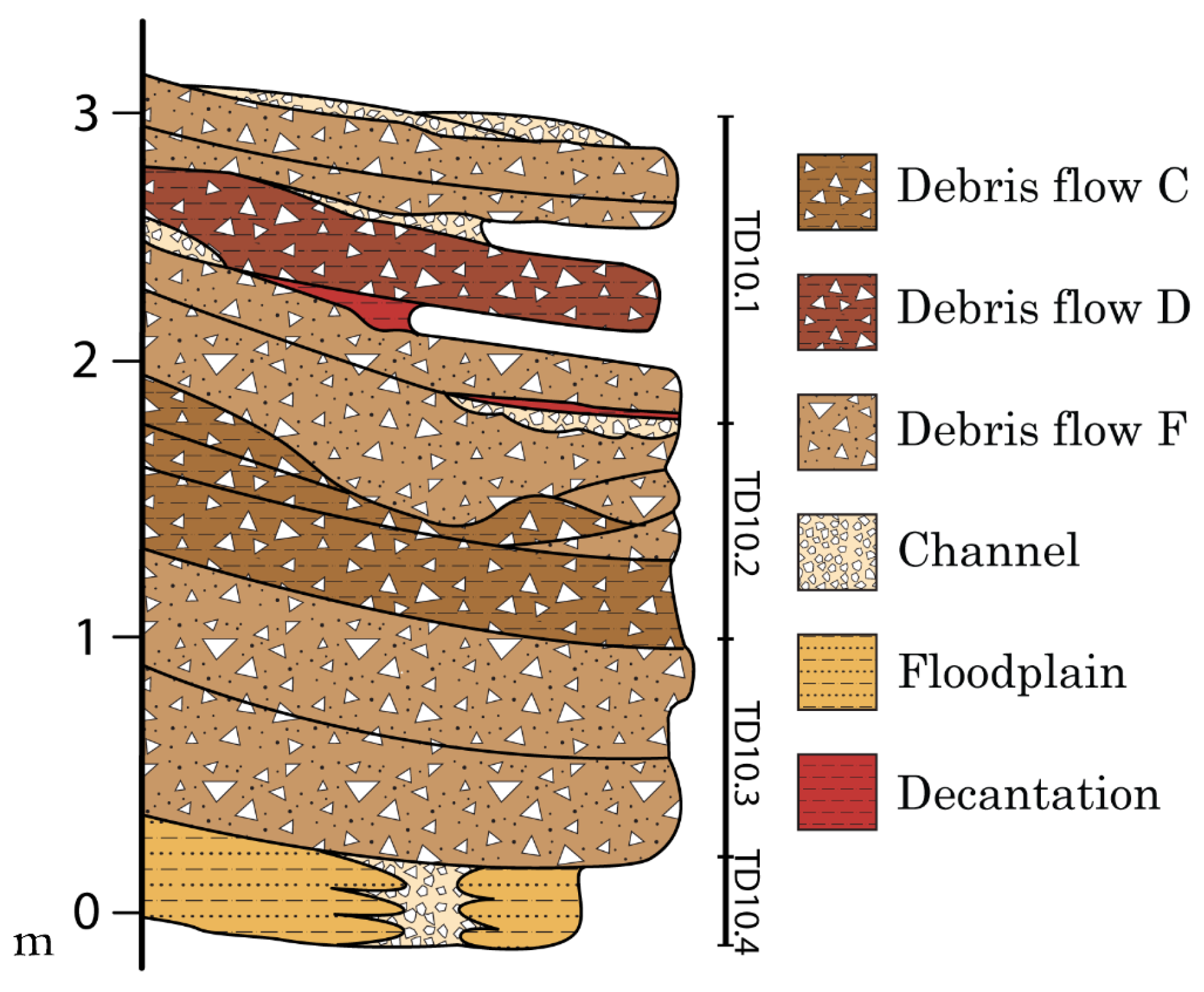

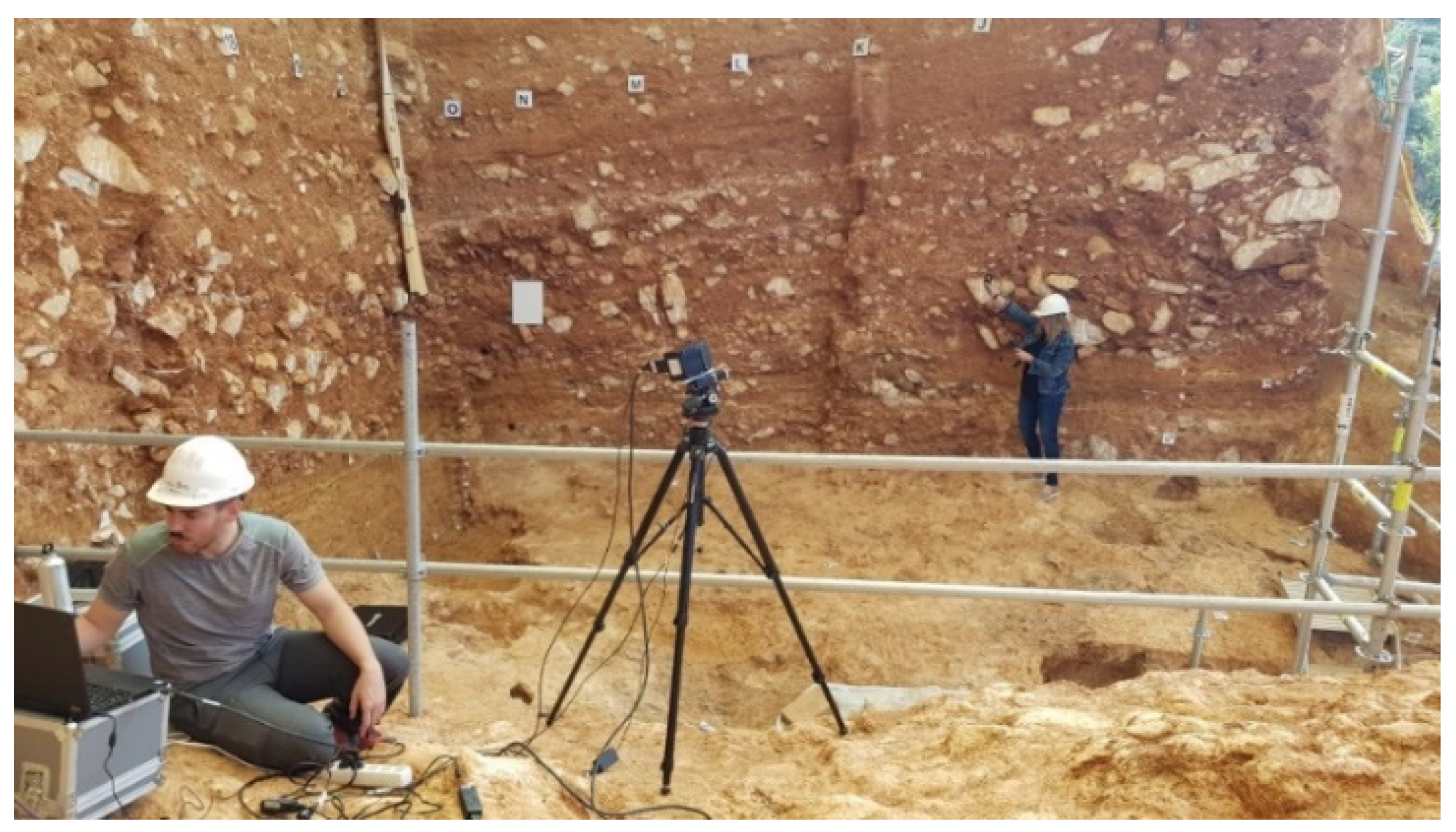

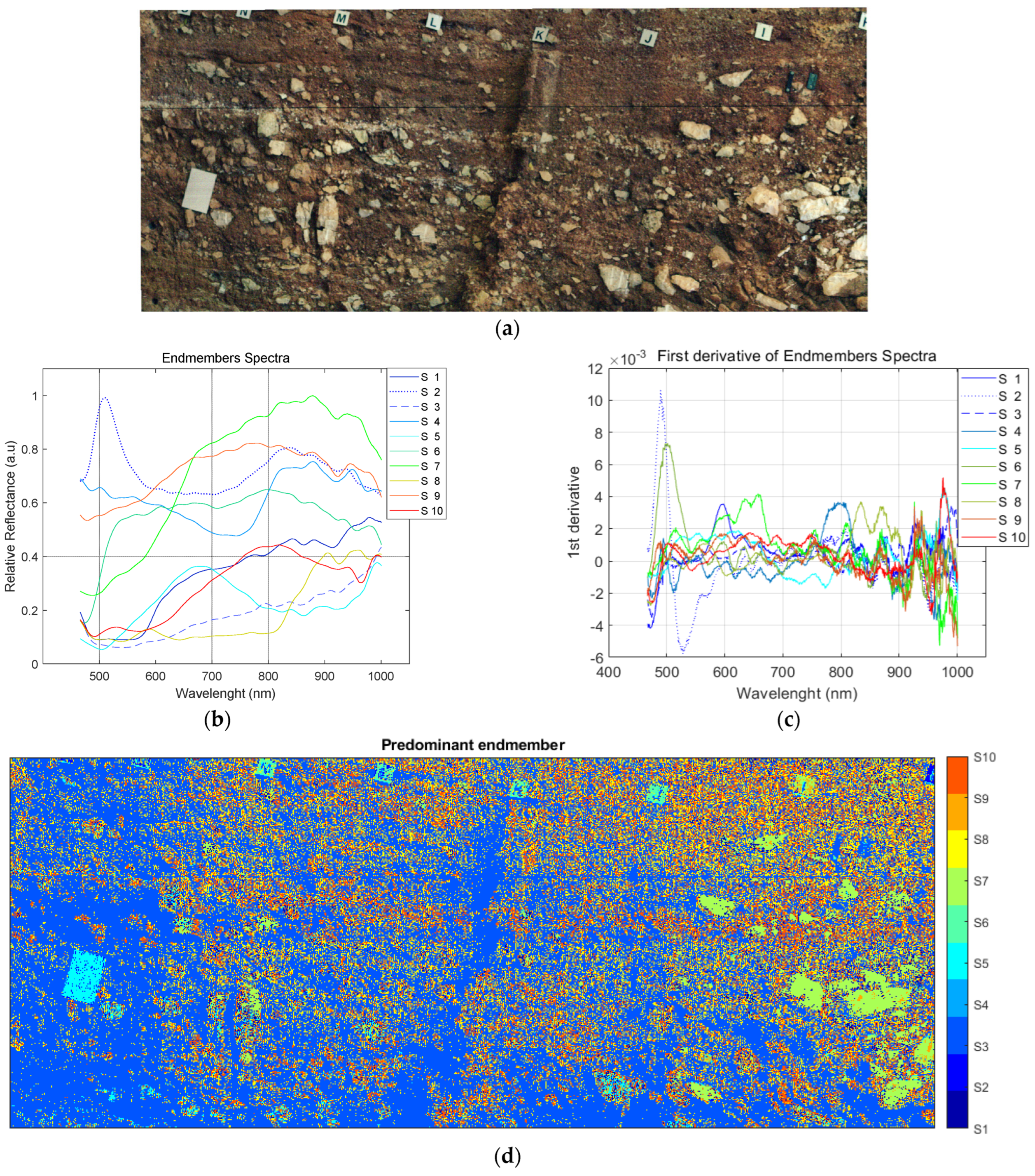


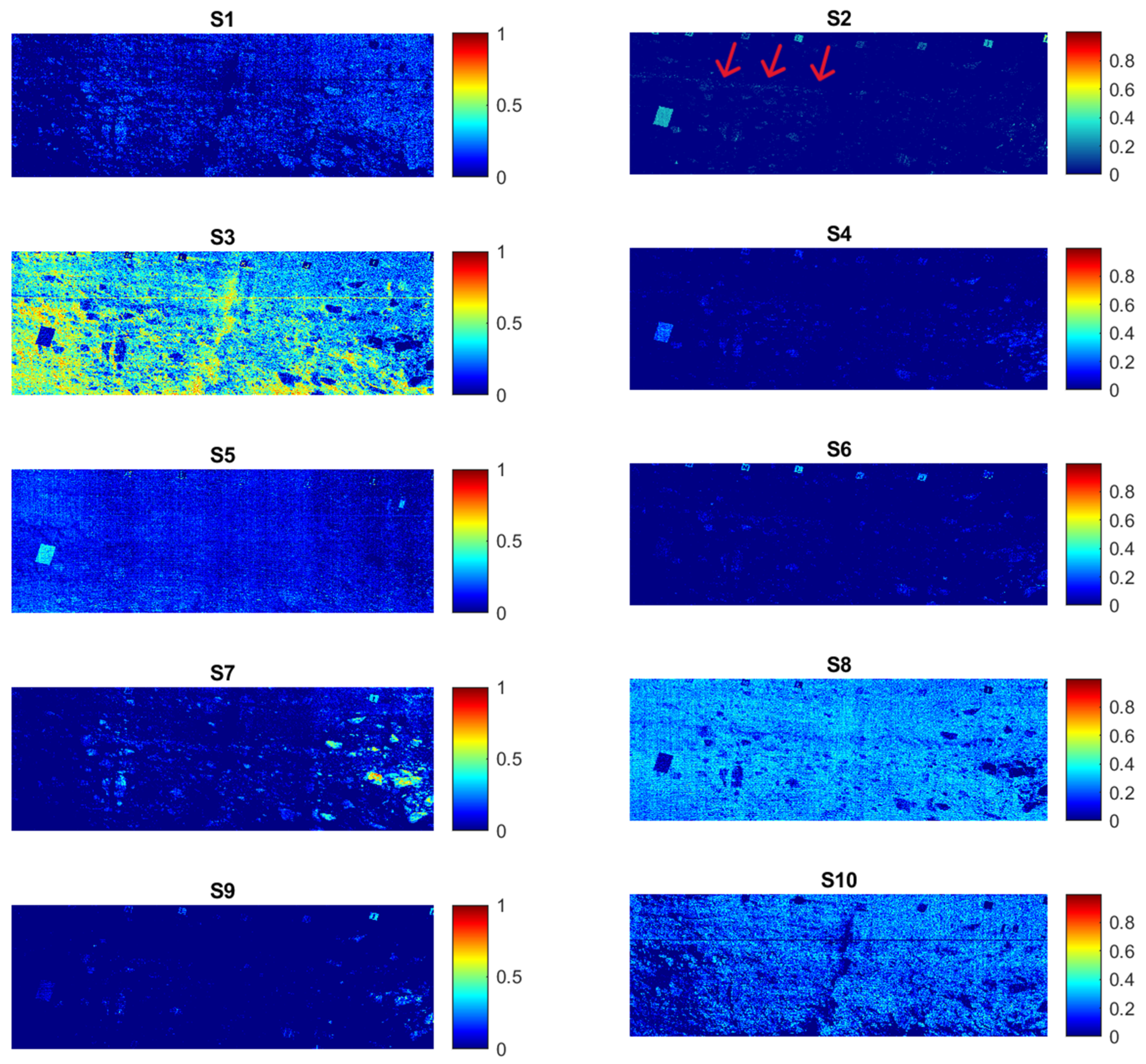


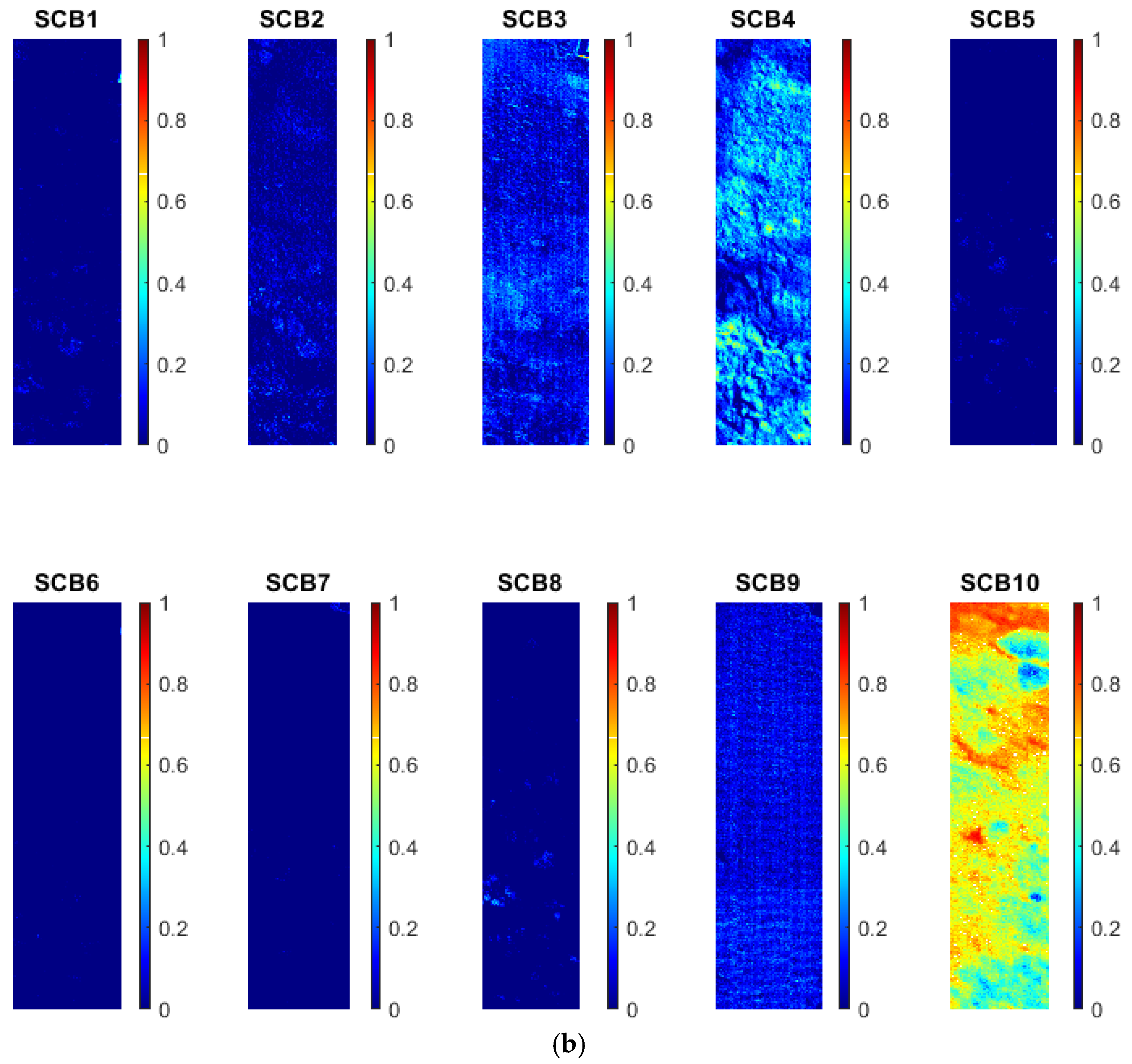
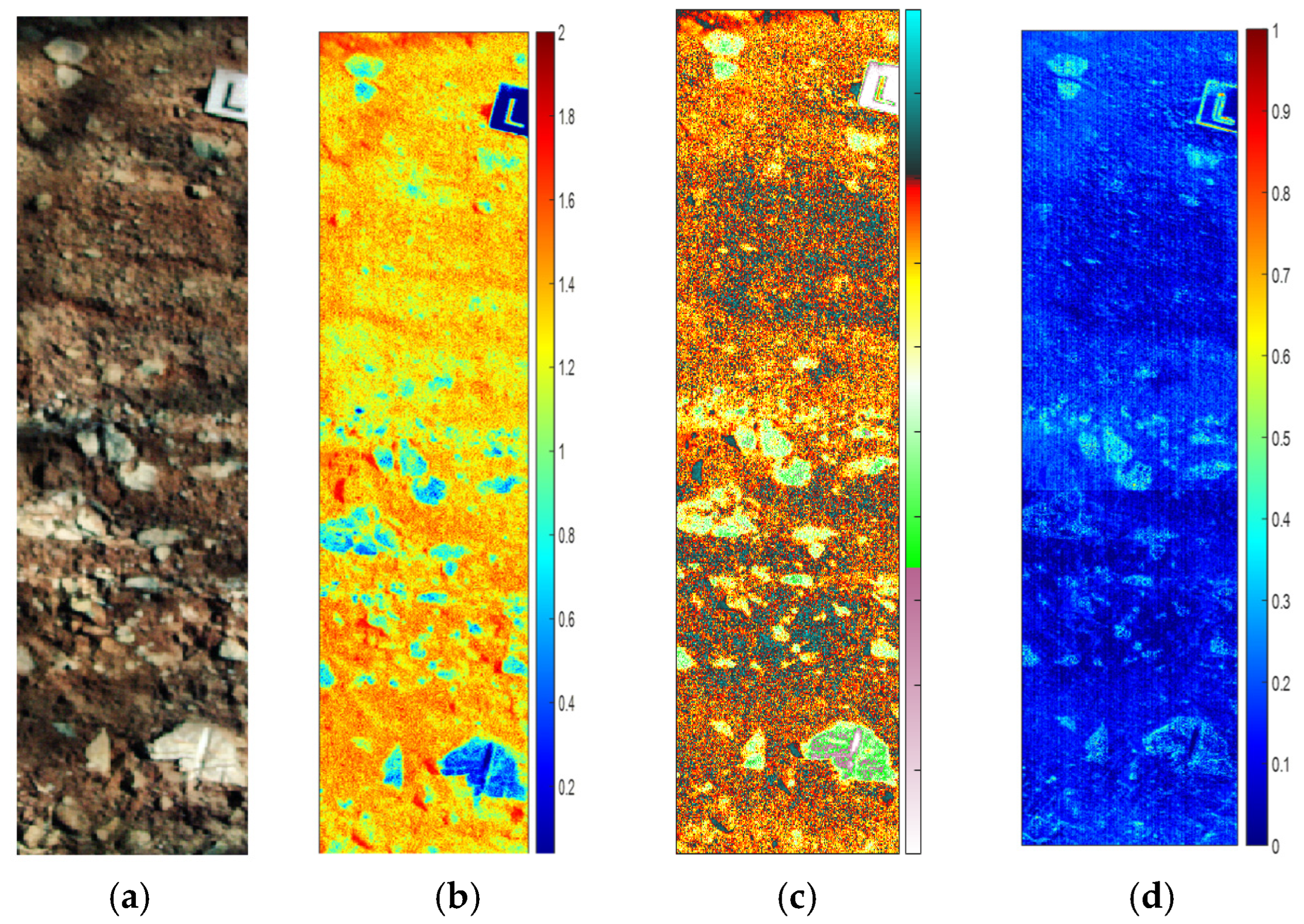
| Facies | Brief Description |
|---|---|
| Debris flow C | Clast-supported boulders with muddy matrix |
| Debris flow D | Matrix-supported boulders and gravels with muddy matrix |
| Debris flow F | Grain-supported boulders |
| Channel | Grain-size decreasing gravels |
| Floodplain | Silts and clays |
| Decantation | Clayey silts |
| Subunit | Layer | Thick (cm) | Facies | Color |
|---|---|---|---|---|
| TD10.1 | 1 | 18 | Channel | Yellowish red 5YR 5/8 |
| 2 | 25 | Debris flow F | Reddish yellow 5YR 6/8 | |
| 3 | 20 | Debris flow F | Reddish yellow 5YR 6/8 | |
| 4 | 15 | Channel | Reddish yellow 5YR 6/8 | |
| 5 | 30 | Debris flow D | Yellowish red 5YR 5/8 | |
| 6 | 25 | Decantation | Yellowish red 5YR 5/6 | |
| 7 | 25 | Debris flow F | Reddish yellow 5YR 6/8 | |
| TD10.2 | 1 | 15 | Channel/decantation | Reddish yellow 5YR 6/8 |
| 2 | 45 | Debris flow F | Reddish yellow 5YR 6/8 | |
| 3 | 35 | Debris flow C | Yellowish red 5YR 5/8 | |
| 4 | 20 | Debris flow F | Reddish yellow 5YR 6/8 | |
| 5 | 30 | Debris flow F | Reddish yellow 5YR 6/8 | |
| 6 | 50 | Debris flow C | Strong brown 7.5YR 5/6 | |
| TD10.3 | 1 | 35 | Debris flow F | Reddish yellow 5YR 6/8 |
| 2 | 45 | Debris flow F | Reddish yellow 5YR 6/8 | |
| TD10.4 | 1 | 30 | Channel/floodplain/decantation | Yellowish red 5YR 5/8 |
| Main Location | Sediment/Object | Surface Morphology | Predominant Spectrum (Spectral Peak) | Endmember |
|---|---|---|---|---|
| TD10 higher in | Mud | Uniform, irregular, decreasing, | Orange-red + IR (Peak 950 nm) | S1 |
| upper right | ||||
| TD10 middle and bottom | Bones, Small stones, gravels, reference targets | Scattered | Bluish-red + IR (Peak 510 nm) | S2 |
| TD10, higher in lower left and central vertical line | Mud | Uniform, increasing | Reddish-brown (Peak 1000 nm) | S3 |
| TD10 central | Bones and limestone | Scattered | Bluish-white–NIR (Peak 950 nm) | S4 |
| TD10 in left, upper and lower zones | Reference targets, stones | Uniform, irregular, increasing | White-red (Peak 880 nm) | S5 |
| TD10 | Reference target | Scattered | White (Peak 800 nm) | S6 |
| TD10, higher in left | Stones | Scattered | White-reddish (Peak 880 nm) | S7 |
| TD10 | Mud | Uniform, irregular | NIR (Peak 900 nm) | S8 |
| TD10 right left | Limestone | Scattered | White (Peak 780 nm) | S9 |
| Entire, higher in upper right corner | Mud | Uniform, irregular, decreasing | Red–NIR (Peak 800 nm) | S10 |
| Main Location | Sediment/Object | Surface Morphology | Predominant Spectrum | Endmember |
|---|---|---|---|---|
| (Spectral Peak) | ||||
| TD10.1, upper right area | Bones, stones | Scattered | White-bluish +NIR (Peak 1000 nm) | Sn1 |
| TD10.1 | Limestone | Scattered | Reddish-brown (Peak 720 nm) | Sn2 |
| TD10.1 | Bones and limestone | Scattered | White + NIR (Peak 690 nm) | Sn3 |
| TD10.1 | Limestone | Scattered | Bluish-white (980 nm) | Sn4 |
| TD10.1 | Bones, stones | Scattered | White peak in red (680 nm) | Sn5 |
| TD10.1 | Mud | Uniform | Brown-reddish–NIR (Peak 990 nm) | Sn6 |
| TD10.1 | Mud | Scattered | Brown-reddish–NIR (Peak 1000 nm) | Sn7 |
| TD10.1 | Mud | Irregular, uniform | Brown-reddish–NIR (Peak 1000 nm) | Sn8 |
Disclaimer/Publisher’s Note: The statements, opinions and data contained in all publications are solely those of the individual author(s) and contributor(s) and not of MDPI and/or the editor(s). MDPI and/or the editor(s) disclaim responsibility for any injury to people or property resulting from any ideas, methods, instructions or products referred to in the content. |
© 2025 by the authors. Licensee MDPI, Basel, Switzerland. This article is an open access article distributed under the terms and conditions of the Creative Commons Attribution (CC BY) license (https://creativecommons.org/licenses/by/4.0/).
Share and Cite
García-Fernández, B.; Benito-Calvo, A.; Martínez-Fernández, A.; Campaña, I.; Ollé, A.; Saladié, P.; Martinón-Torres, M.; Mosquera, M. Hyperspectral Image Assessment of Archaeo-Paleoanthropological Stratigraphic Deposits from Atapuerca (Burgos, Spain). Heritage 2025, 8, 233. https://doi.org/10.3390/heritage8060233
García-Fernández B, Benito-Calvo A, Martínez-Fernández A, Campaña I, Ollé A, Saladié P, Martinón-Torres M, Mosquera M. Hyperspectral Image Assessment of Archaeo-Paleoanthropological Stratigraphic Deposits from Atapuerca (Burgos, Spain). Heritage. 2025; 8(6):233. https://doi.org/10.3390/heritage8060233
Chicago/Turabian StyleGarcía-Fernández, Berta, Alfonso Benito-Calvo, Adrián Martínez-Fernández, Isidoro Campaña, Andreu Ollé, Palmira Saladié, María Martinón-Torres, and Marina Mosquera. 2025. "Hyperspectral Image Assessment of Archaeo-Paleoanthropological Stratigraphic Deposits from Atapuerca (Burgos, Spain)" Heritage 8, no. 6: 233. https://doi.org/10.3390/heritage8060233
APA StyleGarcía-Fernández, B., Benito-Calvo, A., Martínez-Fernández, A., Campaña, I., Ollé, A., Saladié, P., Martinón-Torres, M., & Mosquera, M. (2025). Hyperspectral Image Assessment of Archaeo-Paleoanthropological Stratigraphic Deposits from Atapuerca (Burgos, Spain). Heritage, 8(6), 233. https://doi.org/10.3390/heritage8060233







